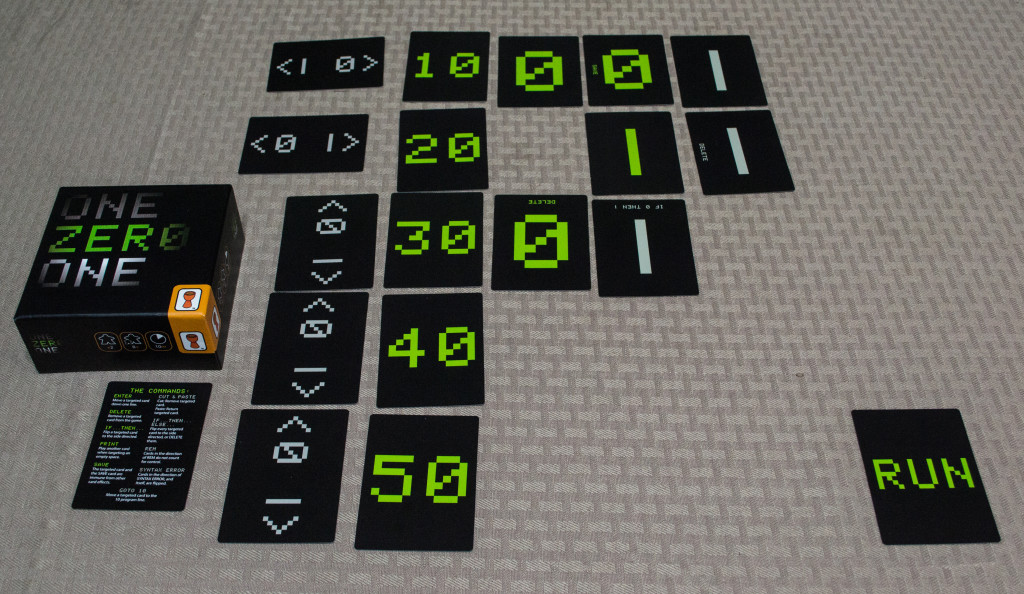01010100 01101000 01101001 01110011 00100000 01101001 01110011 00100000 01100001 00100000 01110010 01100101 01110110 01101001 01100101 01110111 00100000 01101111 01100110 00100000 01110100 01101000 01100101 00100000 01100010 01101111 01100001 01110010 01100100 00100000 01100111 01100001 01101101 01100101 00101100 00100000 01101111 01101110 01100101 00100000 01111010 01100101 01110010 01101111 00100000 01101111 01101110 01100101 00101110
Components
The game includes 44 Command cards (17 green, 17 grey), 5 Line cards, 5 Control cards, 1 RUN card, 2 SYNTAX ERROR cards, 4 CUT cards, 4 PASTE cards, 2 player aid cards, and 1 rule booklet.
Setup & Gameplay
The five line cards are placed in a vertical line with the 10 on top and 50 on the bottom. The five control cards are placed to the left of them in portrait orientation showing that neither the 0 nor 1 is in control of the lines. The RUN card is placed in the fourth position on the 50 line. One player takes the “1” deck while the other takes the “0” deck, taking one basic card (a “0”/”1″ without command text) and placing it aside temporarily. For the basic game, take out the CUT, PASTE, and SYNTAX ERROR cards. They’ll then shuffle their decks, place them number side up, and choose a starting player. The first player places their basic number to the immediate right of the 10, while the second player places their number to the immediate right of the 20. Players draw the top three cards from their deck to form their starting hand.
On a player’s turn, they MUST perform the following three actions:
1. INPUT – Play a card from their hand to the program. The card is played number side up and can be rotated upside-down. It must go in the left-most empty space on a program line (always to the right of the line cards). Except for the 10 and 20 line, no card may be played on the line below it until at least three cards are already placed there (some card commands ignore this rule). Once placed, a card cannot be rotated or moved unless a command forces it to happen. There is no limit to how many cards can be played on a line with the exception of the 50 line…no more than three can be played there as the RUN card takes up the fourth space.
2. EXECUTE – If the card played had command text, it will activate. Commands go into effect immediately upon playing them. The card affected by the command is the card that the command text is directed towards.
3. LOAD – The player draws up to three cards. Players can never have more than three cards and they can never trash cards.
As players lay down cards, they’ll be able to control program lines. To control a program line, the player needs to have more cards of their number on that line than their opponent AND the line must contain at least three cards. When a player controls a line, the control card to the left of the line is rotated appropriately.
The game ends when the third card is played on line 50, or when a player tries to draw a card but can’t because their deck is depleted. Players add up their points by looking to see what lines they control…10 is worth ten points, 20 is worth twenty points, and so on. Whoever has the most points, wins!
Editor’s Note: The above doesn’t cover all of the rules found in the manual, but should give you an idea as to how the game is played.
The Review
At first glance, the game looked complicated (at least to me). Perhaps part of this is due to the fact that I often don’t play games with a theme based around binary and programming language. I used to dabble with Basic, QBasic, and True Basic back when I was younger, but it’s admittedly been a while. Luckily, you wouldn’t have to know an ounce of code to understand how this game is played. Essentially, you’re trying to get more of your number on each of the five lines in order to score points. That’s a gross oversimplification of the rules, but that’s really all it boils down to.
How you accomplish your goals is something altogether different. Some cards contain command text that’s oriented in a particular direction, allowing you to do some helpful or evil things, depending on the situation. The DELETE command removes the neighboring card from the game for example, while the ENTER command allows the player to move the neighboring card to the next line. IF…THEN commands flip one’s to zero’s and vice versa and SAVE protects both it and the neighboring card for the rest of the game. There are some other command cards available in the advanced rule set (SYNTAX ERROR, etc.) should you want to add more chaos to the mix. Players can also opt to show their hands, making the game a lot more strategic as you’ll constantly be trying to plan things out moves in advance.
I like this game…it’s quick and easy to play but still packs a punch strategically. The theme is certainly more unique than most as I don’t have any other game in my collection quite like it. As such, “One Zero One” is very easy to recommend especially at its price point of $15.99 (on Amazon as of 11/13/15).
Final Verdict: 8/10
—
https://www.youtube.com/watch?v=l2JPFSE6qXs

